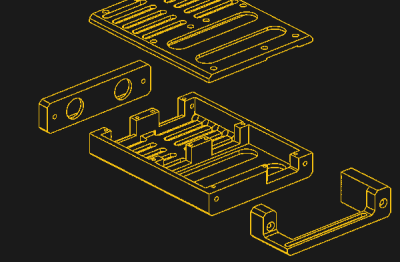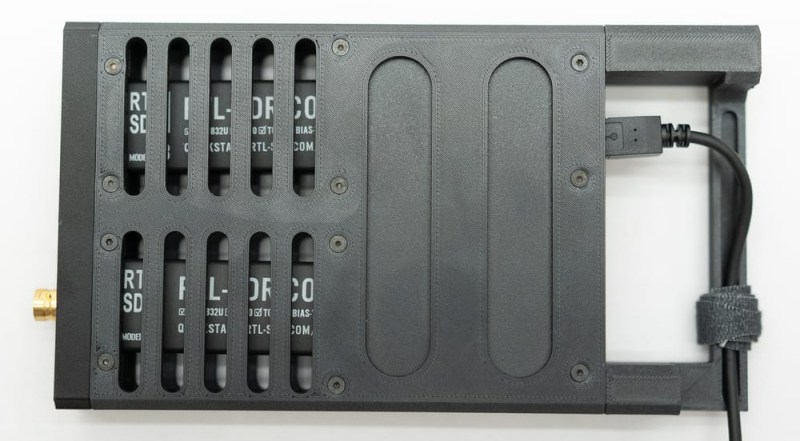We’ll admit to not fully knowing what [Jay Doscher] has planned for the pair of RTL-SDR Blog V4 software defined radios (SDRs) that are enclosed in the slick 3D printed enclosure he’s designed. But when has that ever stopped us from appreciating a nice design when we see one?
 Inside the ventilated enclosure is the aforementioned pair of RTL-SDR Blog V4 (SDRs), as well as a StarTech USB hub that they’re plugged directly into. It seems like it wouldn’t take much to adapt this design to any other pair of USB gadgets, such as flash drives or WiFi adapters.
Inside the ventilated enclosure is the aforementioned pair of RTL-SDR Blog V4 (SDRs), as well as a StarTech USB hub that they’re plugged directly into. It seems like it wouldn’t take much to adapt this design to any other pair of USB gadgets, such as flash drives or WiFi adapters.
In fact, if they’re smaller than the RTL-SDR [Jay] has used here, you could probably get away with only needing to modify the one side panel of the case.
The simple modularity of the design, with two end pieces and the top and bottom plates, makes such modifications easy as you don’t need to reprint the whole thing if you just want a different antenna aperture. It also makes it easy to print without support material, and with just a few tweaks, looks like it could be adapted to use laser-cut panels for the sides. This would not only be faster than printing, but depending on the material, could make for a very stout enclosure.
We’ve covered several designs from [Jay] over the years, including a number of heavy-duty mobile “doomsday” computers that certainly fit in with this same design aesthetic. After all, why not face the end of the world with a little style?















I suspect there may be an issue in their parts list – calls out / links to a USB A -> C cable, but the Startech hub uses a USB-B connector.
I’ve not empirically measured mine but those RTL-SDRs can got pretty hot, like possibly glass-transition-point-of-PLA hot 🔥
Hence why the design is vented and the modules are only held by the ends? And there’s nothing stopping you printing it in PETG…
I would say they get way too d@mn hot. I’d never put my RTL-SDRs in a plastic case without a couple of heatsinks attached to them. Even better with a fan and heatsinks.
I’d be more likely, since you need a computer to run them, just hook them onto an aluminum plate with 3m heat conductive tape, and mount the aluminum plate on the back of my laptop monitor. Antenna connectors up (just above the top of the screen), and USB down.
I’m sure there’s a wonderful plan for these in that case, but that’s not shared with us, so I don’t really see the purpose of this case. It’s nothing special, isnt really innovative, appears overengineered, is expensive to get the CAD file to modify and hack, so why was it posted here?
What am I missing?
They’ll be fine as long as it’s not completely enclosed, allowing for air movement. I designed and printed a case that holds (2) SDRs, nooelec Amplifier and for super duper cooling I have a small computer fan on top that has a duct on top to force cool air over the devices. Works awesome and it’s small. I have the 3 devices side by side . I’ve never had an issue with my SDRs not working so to heat before or after I put them in the case.
Isn’t that basically my point? If you put them in a case you need to cool them.
Sounds like a nice case!
Printing this might be more expensive than two RTLSDRs to begin with. What is wrong with taping them together and calling it a day?
Huh? This is like 50 cents worth of filament, maybe a dollar if you spring for something high-end.
The designer hasn’t open sourced the design and is charging for tiered access to the files.
:^)
It’s $200 subscription for the proprietary CAD files. $30 if you just want the proprietary STLs.
I don’t understand people putting a paywall on such STL given that they probably aren’t using a commercial CAD software to start with and it’s a bit scummy. Just open it up free and accept donations. 200$/year is a joke.
I’ve designed 3D models with twice the complexity for paying customer and that was 25$, for a single customer keep in mind.
Hackaday shouldn’t promote paid services like that either, it’s against the core values of “hacking” hardware to start with.
Hi Jay, this is Jay the creator of this build. I am in fact using commercial CAD software, and all of my builds take significant amounts of time to build- albeit some more than others. While I appreciate your suggestion to make it free, but if you notice my minimum signup fee is $5 and covers not just STL access to this build, but every STL I have ever released. That goes for the CAD files too, the CAD tier covers every single CAD file I have ever done. This is intentional and helps support these builds. While I understand you are more than capable of designing this build, I still hope you enjoy seeing the idea behind it without getting too caught up in this random Internet person trying to get $5.
J.D., it’s not $5, it’s a tiered subscription which begins at $5/month, and subscriptions trade much more on faith than on the exact cost versus reward. People don’t like to pay for anything for a month and realize they didn’t get any benefit from their money, or to enter into an agreement to repeatedly pay for something until they’re already sure they are going to want it in the future. Then you add the fact that from what I see on there, you’ve not kept the same website or subscription terms for more than a few months so far and it’s just you there, so it could all disappear at any time. If this subscription is more on the lines of getting support from any fans you may have, then maybe it could make sense. But someone who just finds that you’ve made something they’d like to duplicate and (like me) has never heard of you is going to have legitimate and obvious reasons not to be keen on signing up when what they really want is just that one design.
It won’t let me reply to your other comment, but for others finding this in the future, plenty of people sign up for just a month to get a design and cancel! Good luck and best wishes!
Jesus. If somebody buys me two of the RTL-SDR blog V4’s for me to keep, I’ll CAD up a similar case to their specifications 😂
Sure, it would be nice if the files were open source. No question. But we can also just use this project as inspiration to build something similar, not every project that’s featured needs to be replicated exactly.
To me, that’s always been the joy of seeing things on Hackaday. Rarely do I want to copy something 100%, but daily I am inspired by something I see here to create something of my own.
Now, add another one or three SDRs, crack them open and drive them from a common master clock, then you really have a neat phase-locked multi-receiver setup for synthetic phased array reception. A Kraken.
Interesting. How would this work?
Like this:
https://ptrkrysik.github.io/
Or (since this article is promoting a paid product), maybe these folks could sell you something:
https://coherent-receiver.com/
I’m assuming this was motivated by the complete failure by Vlad from FOSA Tech, formerly known as Terminal Armament to deliver on SDT-STK device that they took orders on. I wish this could be pushed out to everyone who ordered one of those, and never received it.
I am one who never received my SDT-STK + accessories from Vlad. Out almost $300, ghosted. No response since Feb 2024 stating next batch would go out Mar 2024 and here we are. Nada
wow my first thought is i throw together little cases like this all the time, like i have a truly trivial case for my raspberry pico (rp2040) board. just so i can leave it in a pile in the livingroom without concern. they’re nice but hardly worth writing an article about, imo. more than anything i love the ability to make an endless variety of simple cases, more than i love any single case i’ve made.
and then i noticed what seems to me to be geometric overdesign. the modularity seems all liability to me — if i did it that way it would simply be because of the small build volume of my printer.
but the overuse of fasteners really jumps out at me. one of the things i’ve come to love about 3d printing is that generally it doesn’t take much attention to design in order to make most things hold together really well with just two (2) screws, or even just a single pin or so on. i’m not rabid about reducing fastener count but i would definitely never put 11 screws (especially 11 of the most expensive screws) just for the face of something. honestly for this i would be really inclined to hold it together with a combination between overhangs and a single small piece of painters tape. amazing how well that sort of thing works, and how easy it is to service it too.
but asking for money for this design really takes the cake. i’m suddenly impressed. there is a noteworthy innovation here, after all.
Why does one need a case to hold together two rtl-sdr s? They aren’t transceivers where each can only be a transmitter or reciver, not both, at a given instant. RTL-SDR is receive only, two can’t become a transceiver capable of simultaneous transmit and receive, so what is the practical purpose for two working together?
someone suggested linking their clocks together and using it to discern phase (and hence direction and distance), which i think is really cool but i doubt was the intent of this project. i think it’s just if you want to monitor multiple bands at the same time, or if you want to have one hooked up to a long antenna and the other hooked up to a short antenna, without having an antenna switching box.
I want to know what software is being used to observe two SDRs at the same time.